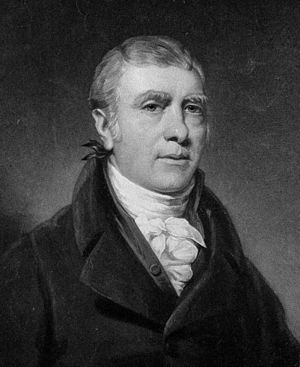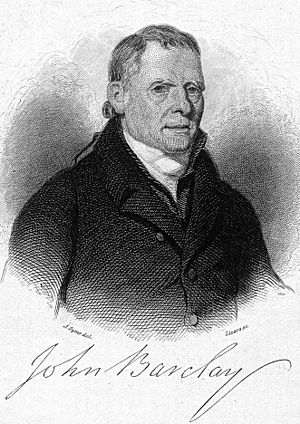John Barclay (anatomist) facts for kids
John Barclay (born 10 December 1758 – died 21 August 1826) was a Scottish expert in comparative anatomy. This means he studied how the bodies of different animals are built and how they work, comparing them to each other. He was also a popular teacher of anatomy outside the main university and helped lead the Highland Society of Scotland.
Contents
Early Life and Education
John Barclay was born in a place called Cairn in Perthshire, Scotland, on 10 December 1758. His father was a farmer. His uncle, also named John Barclay, started a church called the Berean Church.
John Barclay first went to school at Muthill parish school. Then, he studied to become a minister at the University of St Andrews. After working as a minister for a while, he became a tutor for a family. During this time, he taught himself a lot about biology and anatomy.
Becoming an Anatomy Teacher
In 1789, some of his students went to the University of Edinburgh. Barclay then became an assistant to a famous anatomist named John Bell. He also worked with John Bell's brother, Charles Bell. A kind employer, Sir James Campbell, helped pay for Barclay to finish his medical studies.
Barclay earned his medical degree (M.D.) from Edinburgh. After that, he spent a year in London, studying anatomy even more with another teacher named Andrew Marshall.
In 1797, he came back to Edinburgh and started teaching anatomy himself. He became very well-known. Every winter, until 1825, he taught two full courses on human anatomy. For several years before he passed away, he also taught a summer course on comparative anatomy, which is about comparing the bodies of different animals.
His classes became more and more popular. In 1804, the Edinburgh College of Surgeons officially recognized him as a lecturer. In 1806, he became a fellow of the Edinburgh College of Physicians.
A New Idea for the University
In 1816, there was a plan to create a new teaching position at the University of Edinburgh specifically for comparative anatomy. John Barclay was the top choice for this job. However, some of the existing medical professors at the university did not want this new position. They were worried it would affect their own teaching areas.
These professors, including John Hope, Robert Jameson, and Alexander Monro, tertius, worked together to stop the idea. This event was even made fun of in a famous cartoon by John Kay. The cartoon showed Barclay trying to enter the university on an elephant skeleton, but being blocked by the other professors.
Later Years and Passing
For the last two years of his life, John Barclay was too unwell to teach. His classes were taken over by Robert Knox, who had been one of his students.
John Barclay passed away in Edinburgh on 21 August 1826. He was buried in Restalrig Churchyard, which is on the east side of the city.
His Important Works
John Barclay wrote many important things about anatomy:
- He wrote the article on Physiology for the third edition of the third edition of the Encyclopædia Britannica in 1797. Physiology is the study of how living things work.
- In 1803, he published A New Anatomical Nomenclature. In this book, he shared his ideas for a new way to name parts of the human body based on scientific rules.
- In 1808, he wrote The Muscular Motions of the Human Body. This book explained how human muscles move, organized by different body parts, and how this knowledge could help in surgery.
- His book Description of the Arteries of the Human Body came out in 1812. This book was based on his own studies and dissections. A second version of this book was published in 1820.
- He also wrote descriptions for a series of pictures showing the human skeleton and the skeletons of some animals. These pictures were made by Edward Mitchell in Edinburgh between 1819 and 1820.
- Some of his anatomy lectures were published after he died in 1827.
- In 1822, he published An Inquiry into the Opinions, Ancient and Modern, concerning Life and Organisation. In this book, Barclay strongly supported the idea of vitalism. This idea suggests that living things have a special "life force" that non-living things don't. He argued against thinkers who believed life could be explained only by physical and chemical processes.
Family Life
In 1811, John Barclay married Eleanora. She was the daughter of Sir James Campbell of Aberuchill, who had been his employer. They did not have any children. After John Barclay's death, Eleanora married Charles Oliphant.
His Lasting Impact
In 1821, John Barclay gave his large collection of animal and human specimens to the Royal College of Surgeons of Edinburgh. He had one condition: a special hall had to be built to show all his materials together, and it had to be named after him. In 1828, his collection became known as the Barcleian Museum. Today, you can still see parts of his amazing collection at Surgeons' Hall in Edinburgh.
Some of His Students
Many students learned from John Barclay and became important figures themselves, including:
- Sir George Ballingall (1780–1855)
- William Dick (1793–1866)
- Dr Robert Knox (1791–1862)
- Robert Liston (1794–1847)
- Robert Nasmyth (1791–1870)
- James Syme (1799–1870)
- William Sharpey (1802–1880)




